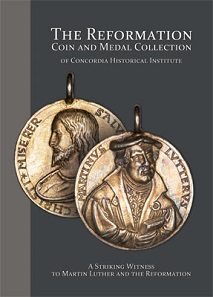by Ursula Kampmann
translated by Annika Backe
November 3, 2016 – Martin Luther is said to have nailed his Ninety-five Theses to the door of Castle Church in Wittenberg on October 31, 1517. No matter if this date is historically accurate or not, the Protestant Church throughout the world is about to properly celebrate this date’s 500th anniversary with a big Reformation jubilee.
With this, the Church remains true to a century-old tradition. Every fifty years, generations of believers used to commemorate the climax of the Reformation with elaborate festivities – and, as a keepsake, mint comprehensive series of coins.
Daniel Nathan Harmelink (ed.), The Reformation: Coin and Medal Collection of Concordia Historical Institute. A Striking Witness to Martin Luther and the Reformation. Concordia Publishing House, Saint Louis, Missouri (2016). 309 pages with color illustrations throughout. 23 x 31 cm. ISBN 1-800-325-3040. $59.99 (plus postage and packaging).
In the U.S., Rev. Daniel Nathan Harmelink has made it his goal to further disseminate knowledge about this numismatic legacy of Lutheranism. In 2010, he founded the International Association of Reformation Coins and Medals (IARCM), aiming at preparing the 500th jubilee and making the numismatic testimonies related to the Reformation better known.
A further step in this direction is the publication of the Concordia Historical Institute Collection in a lavishly illustrated catalog. Concordia Historical Institute is the Department of Archives and History, belonging to the Lutheran Church – Missouri Synod. Having become affiliated to this institution in 1927, the Institute houses all records of the Synod since 1847. Already prior to that date, it had come into the possession of a large collection of numismatic testimonies to the Reformation which was then expanded successively by further donations, most notably the Edwin Theodore Schumm Collection. The Institute’s collection currently comprises 834 specimens, all thoroughly described and documented through photos in the catalog.
The coins are arranged according to the year of issue stated in the legend. The description of every coin and medal includes denomination, material, occasion, medalist, description, weight and diameter as well as several citations. To help mainly the layperson, not trained in numismatic matters, using the catalog, the editor puts a comprehensive foreword in front of the catalog. The text is rooted in faith, and being a Catholic who is a little bit acquainted with the history and the medals from the period of the Counterreformation, the reviewer is entitled to doubt the truth of statements like “by the grace of God, Reformation numismatics achieved something Rome was unable to attain: the skillful use of the medallic art to move beyond the satirical and give a positive witness and apologetic to the commands and promises of Christ revealed in the Holy Scriptures and delivered in the redeeming Sacraments of Baptism and the Lord’s Supper”. Rome was quite capable of this and as eager to document numismatically its view of the Gospel as the Protestant side.
Anyway, coins and medals issued on the occasion of the Reformation were a token of faith at all times. In this light, this approach might well enrich our understanding of the subject. The introduction not only refers to the most important books on Reformation numismatics but introduces into the meaning of the symbols and scripture references used on coins.
It is to be hoped that the author fills many admirers of Luther, hitherto not so much interested in numismatics, with a fascination for the topic. You see, the enthusiasm of editor Daniel Nathan Harmelink is infectious! As already stated in the Bible, Matthew 5.14-15: You are the light of the world. A town built on a hill cannot be hidden. Neither do people light a lamp and put it under a bowl. Instead they put it on its stand, and it gives light to everyone in the house.
The publisher currently offers the book at a discount. You can place an order here.
You can find more information on the International Association of Reformation Coins and Medals in our report.
Together with Victor Huster, the IARCM issued several medals, as the medal on the occasion of the 500th jubilee, the one on Carl Ferdinand Wilhelm Walther, famous leader of the Protestant movement in the U.S., and another one on Jan Hus.





